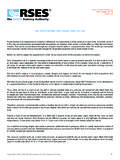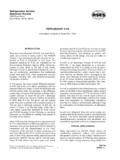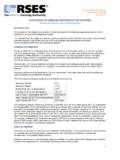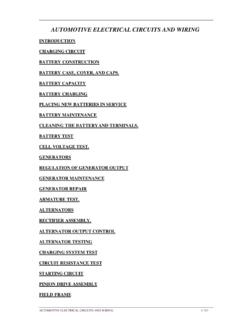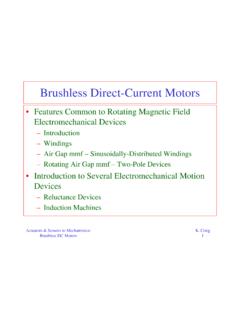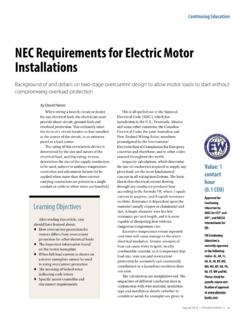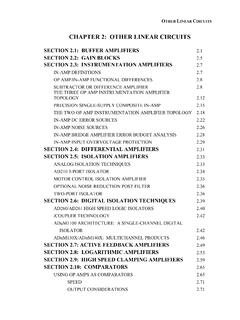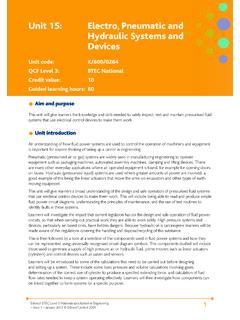Transcription of TERMINAL MARKINGS AND INTERNAL WIRING …
1 Service Application Manual SAM Chapter 620-37 Section 6A TERMINAL MARKINGS AND INTERNAL WIRING DIAGRAMS SINGLE PHASE AND POLYPHASE MOTORS MEETING NEMA STANDARDS INTRODUCTION The following represents the most up-to-date information on motor TERMINAL marking for proper connection to power source for all alternating current motors manufactured in accordance with standards adopted by the National Electrical Manufacturers Association. In addition, this section contains important data covering INTERNAL WIRING to motor terminals which will prove invaluable to the Refrigeration Service Engineer in solving motor problems. The source of this information is Part 2 of the NEMA Standards Publication, for which reprint permission was granted RSES by the National Electrical Manufacturers' Association. MG LOCATION OF TERMINAL MARKINGS TERMINAL MARKINGS shall be placed on or directly adjacent to terminals to which connections must be made from outside circuits or from auxiliary devices which must be disconnected for shipment.
2 Wherever specified, color coding may be used instead of the usual letter and numeral marking .* MG TERMINAL MARKINGS A combination of capital letters or symbols and an arabic numeral shall be used to indicate the character or function of the windings which are brought to the TERMINAL .* The following letters and symbols shall be used for motors and generators and their auxiliary devices when they are included within or mounted on the machine.* Resistance (shunt field adjusting) V1, V2, V3, etc. Shunt braking resistor DR1, DR2, DR3, DR4, etc. Space heaters H1, H2, H3, H4, etc. Stator T1, T2, T3, T4, etc. Starting switch K. TERMINAL protector P1, P2, P3, P4, etc. Equalizing lead = (equality sign). Neutral connection TERMINAL letter with numeral 0. For the significance of the arabic numeral, see MG for alternating-current machines. For alternating-current machines only. Armature A1, A2, A3, A4, etc. Brake B1, B2, B3, B4, etc. Alternating-current rotor windings (collector rings) M1, M2, M3, M4, etc.
3 Capacitor J1, J2, J3, J4, etc. Control signal lead attached to commutating winding C. 1 Service Application Manual SAM Chapter 620-37 Section 6A TERMINAL MARKINGS AND INTERNAL WIRING DIAGRAMS SINGLE PHASE AND POLYPHASE MOTORS MEETING NEMA STANDARDS Dynamic braking resistor BR1, BR2, BR3, BR4, etc. Field (series) S1, S2, S3, S4, etc. Field (shunt) F1, F2, F3, F4, etc. Line L1, L2, L3, L4, etc. Magnetizing winding (for initial and maintenance magnetization and demagnetization of permanent magnetic fields) E1, E2, E3, E4, etc. (NOTE E1, E3, or other odd-numbered terminals should be attached to the positive TERMINAL of the magnetizing power supply for magnetization and to the negative TERMINAL for demagnetization.) Resistance (armature and miscellaneous) R1, R2, R3, R4, etc. * Approved as NEMA Standard 11-16-1967 Approved as Authorized Engineering Information 11-16-67 Added as NEMA Standard 11-16-68 ALTERNATING-CURRENT MOTORS AND GENERATORS MG Numerals on Terminals Of Alternating-Current Polyphase Machines A.
4 SYNCHRONOUS MACHINES The numerals 1, 2, 3, etc., indicate the order in which the voltages at the terminals reach their maximum positive values (phase sequence) with clockwise shaft rotation when facing the connection end of the coil windings: hence, for counterclockwise shaft rotation (not standard) when facing the same end, the phase sequence will be 1, 3, 2. B. INDUCTION MACHINES TERMINAL MARKINGS of polyphase induction machines are not related to the direction of rotation. * Approved as NEMA Standard 11-16-1967 Approved as Authorized Engineering Information 11-16-1967 MG Definition Of Phase Sequence Phase sequence is the order in which the voltages successively reach their maximum positive values between terminals.* MG Phase Sequence The order of numerals on TERMINAL leads does not necessarily indicate the phase sequence, but the phase sequence is determined by the direction of shaft rotation relative to the connection end of the coil winding.
5 MG Direction Of Rotation Of Vectors Vector diagrams shall be shown so that advance in phase of one vector with respect to another is in the counterclockwise direction. 2 Service Application Manual SAM Chapter 620-37 Section 6A TERMINAL MARKINGS AND INTERNAL WIRING DIAGRAMS SINGLE PHASE AND POLYPHASE MOTORS MEETING NEMA STANDARDS See Fig. 2-11 in which vector 1 is 120 degrees in advance of vector 2 and the phase sequence is 1, 2, 3. (See MG )* MG Direction Of Rotation The standard direction of rotation for alternating generators is clockwise when facing the end of the machine opposite the drive.* The direction of rotation of a generator mounted as a part of an engine-generator set is usually counterclockwise when facing the end opposite the drive. The standard direction of rotation for all alternating-current single-phase motors, all synchronous motors, and all universal motors shall be counterclockwise when facing the end of the machine opposite the drive.
6 * MG Reversal Of Rotation, Polarity And Phase Sequence Alternating-current generators driven counterclockwise when facing the connection end of the coil windings will generate without change in connections, but the TERMINAL phase sequence will be 1, 3, 2. Synchronous condensers and synchronous motors may be operated with counterclockwise shaft rotation viewed from the connection end of the coil windings by connecting them to leads in which the phase sequence is 1, 2, 3, in the following manner: Power 1, 2, 3 Machine , 3, 2 ALTERNATING-CURRENT GENERATORS AND SYNCHRONOUS MOTORS MG Connections And TERMINAL MARKINGS Alternating-Current Generators And Synchronous Motors One, Two, And Three Phase The alternating-current windings of three-phase alternating-current generators and synchronous motors shall have TERMINAL MARKINGS as given in MG for three-phase single-speed induction motors.* The alternating-current windings of two-phase alternating-current generators and synchronous motors shall have TERMINAL MARKINGS as given in MG for two-phase single-speed induction motors.
7 * The alternating-current windings of single-phase alternating-current generators and synchronous motors shall have TERMINAL MARKINGS as given in Fig. 2-12.* 3 Service Application Manual SAM Chapter 620-37 Section 6A TERMINAL MARKINGS AND INTERNAL WIRING DIAGRAMS SINGLE PHASE AND POLYPHASE MOTORS MEETING NEMA STANDARDS The TERMINAL MARKINGS of direct-current field windings shall be F1 and F2.* NOTE: See MG for TERMINAL letters assigned to different types of windings and MG for the significance of the numerals. SINGLE-PHASE MOTORS MG General A. DUAL VOLTAGE Regardless of type, when a single-phase motor is reconnectible series-parallel for dual voltage, the TERMINAL marking shall be determined as follows:* For the purpose of assigning TERMINAL MARKINGS , the main winding is assumed to be divided into two halves, and T1 and T2 should be assigned to one half and T3 and T4 to the other half.* For the purpose of assigning TERMINAL MARKINGS , the auxiliary winding (if present) is assumed to be divided into two halves, and T5 and T6 should be assigned to one half and T7 and T8 to the other half.
8 * Polarities shall be established so that the standard direction of rotation (counterclockwise facing the end opposite the drive) is obtained when the main winding TERMINAL T4 and the auxiliary winding TERMINAL T5 are joined or when an equivalent circuit connection is made between the main and auxiliary winding.* The TERMINAL marking arrangement is shown diagrammatically in Fig. 2-13.* 4 Service Application Manual SAM Chapter 620-37 Section 6A TERMINAL MARKINGS AND INTERNAL WIRING DIAGRAMS SINGLE PHASE AND POLYPHASE MOTORS MEETING NEMA STANDARDS B. SINGLE VOLTAGE If a single-phase motor is single voltage or if either winding is intended for only one voltage, the TERMINAL marking shall be determined as follows.* T1 and T4 shall be assigned to the main winding and T5 and T8 to the auxiliary winding (if present) with the polarity arrangement such that the standard direction of rotation is obtained if T4 and T5 are joined to one line and T1 and T8 to the other.
9 * The TERMINAL marking arrangement is shown diagrammatically in Fig. 2-14.* 5 Service Application Manual SAM Chapter 620-37 Section 6A TERMINAL MARKINGS AND INTERNAL WIRING DIAGRAMS SINGLE PHASE AND POLYPHASE MOTORS MEETING NEMA STANDARDS 6 NOTE: It has been found to be impracticable to follow this standard for the TERMINAL MARKINGS of some definite-purpose motors. See Part 18. NOTE: No general standards have been developed for TERMINAL MARKINGS of multispeed motors because of the great variety of methods employed to obtain multiple speeds. MG TERMINAL MARKINGS Identified By Color When single-phase motors use lead colors instead of letter and number MARKINGS to identify the leads, the color assignment shall be determined from the following:* T1 Blue T2 White T3 Orange T4 Yellow T5 Black T8 Red P1 No color assigned P2 Brown NOTE: It has been found to be impracticable to follow this standard for the lead MARKINGS of some definite-purpose motors.
10 See Part 18. MG Auxiliary devices Within motor The presence of an auxiliary device or devices , such as a capacitor, starting switch, TERMINAL protector, etc., permanently connected in series between the motor TERMINAL and the part of the winding to which it ultimately connects shall not affect the marking unless a TERMINAL is provided at the junction.* Where a TERMINAL is provided at the junction, the TERMINAL marking of this junction shall be determined by the part of the winding to which it is connected. Any other terminals connected to this auxiliary device shall be identified by a letter indicating the auxiliary device within the motor to which the TERMINAL is connected.* MG Auxiliary devices External To motor Where the capacitors, resistors, inductors, transformers or other auxiliary devices are housed separately from the motor , the TERMINAL MARKINGS shall be those established for the device.* Service Application Manual SAM Chapter 620-37 Section 6A TERMINAL MARKINGS AND INTERNAL WIRING DIAGRAMS SINGLE PHASE AND POLYPHASE MOTORS MEETING NEMA STANDARDS MG marking Of Rigidly-Mounted Terminals On a TERMINAL board, the identification of rigidly-mounted terminals shall be either by marking on the TERMINAL board or by means of a diagram attached to the machine.
